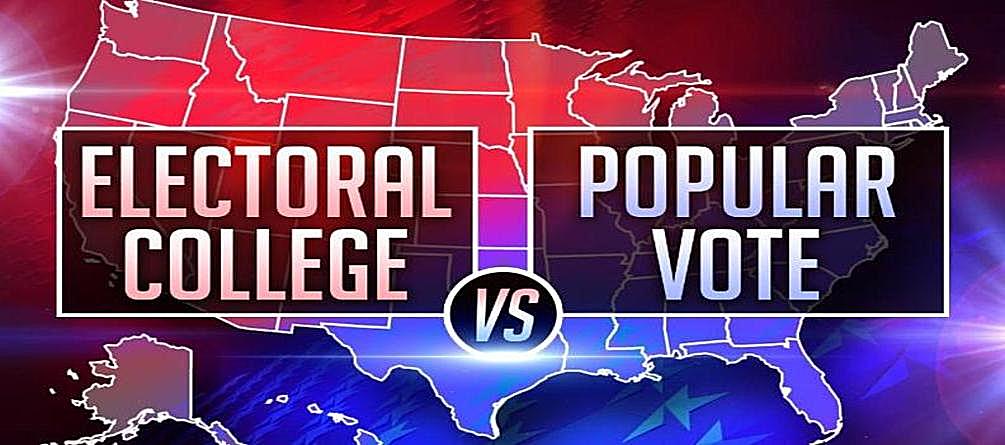
In the 2000 election, the winner George W. Bush won 5 more Electoral College votes than the loser Al Gore, but Al Gore won 543,895 more Election Day people votes than George W. Bush. In the 2016 election, the winner Donald Trump won 77 more Electoral College votes than the loser Hillary Clinton, but Hillary Clinton won 2,868,686 more Election Day people votes than Donald Trump. The results of both these elections raise the question should we get rid of the Electoral College and make one person one vote real in America?
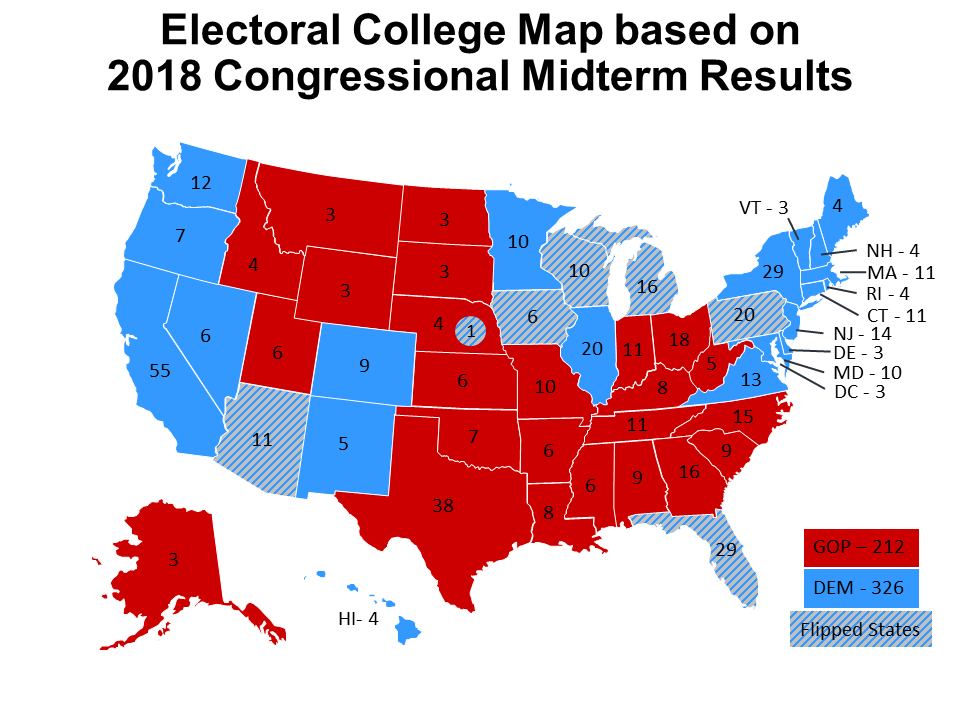
The short and logical answer is no. Believe it or not in America, the world’s freest democracy, when it comes to electing the President and the world’s most powerful person, one person one vote should NOT be real. It’s currently not real by design. The founding fathers established the Electoral College in the Constitution as a compromise between election of the President by a vote in Congress and election of the President by a popular vote of the citizens.
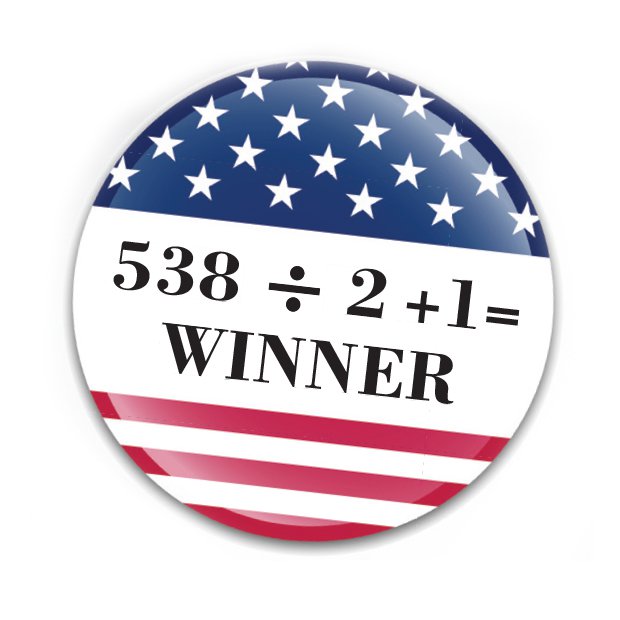
The Electoral College works a lot like Congress: The U.S. is divided into 435 congressional districts, each of about 710,000 people. Each district elects one person to the House of Representatives. Every state elects two senators. Electoral College votes are allocated the same way. (The District of Columbia is the exception; it doesn’t have representation in Congress, but it gets three electoral votes.) There are 538 total electors, each with one vote
The Electoral College is made up of 538 electors who meet in December following the national election and cast the ACTUAL votes that determine who is elected President. A person must receive 270 electoral votes to be elected. The 538 electors come from all 50 states and Washington D.C., each state’s number of electors is equal to the number of Congresspersons and Senators they have. One elector for each Congressperson and one for each Senator and Washington D.C. gets 3 electors making the total 538.
On Election Day citizens of America symbolically vote for the candidate of their choice but actually vote for a pre-chosen slate of state electors who will then cast the actual votes to elect the President. State electors meet in their respective state capitals in December to cast their votes. Once the results are certified by the states and D.C. they are then sent to Congress, where they are tabulated nationally in the first week of January before a joint meeting of the Senate and House of Representatives. In the event that no candidate received the necessary 270 Electoral College votes, the House without the Senate would themselves vote to decide the election.
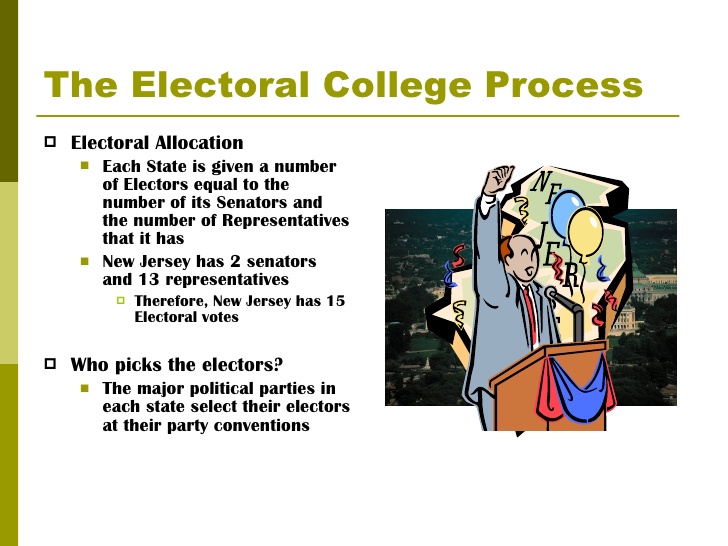
The founding fathers designed the Electoral College because they didn’t think that citizens could be trusted to elect a President for the right reasons due to ignorance, gullibility, or manipulation of citizen’s emotions and passions. Alexander Hamilton writes in “The Federalist Papers,” The point of the Electoral College is to preserve “the sense of the people,” while at the same time ensuring that a president is chosen “by men most capable of analyzing the qualities adapted to the station, and acting under circumstances favorable to deliberation, and to a judicious combination of all the reasons and inducements which were proper to govern their choice.”
James Madison worried about what he called “factions,” which he defined as groups of citizens who have a common interest in some proposal that would either violate the rights of other citizens or would harm the nation as a whole. Madison’s fear – which Alexis de Tocqueville later dubbed “the tyranny of the majority” – was that a faction could grow to encompass more than 50 percent of the population, at which point it could “sacrifice to its ruling passion or interest both the public good and the rights of other citizens.”
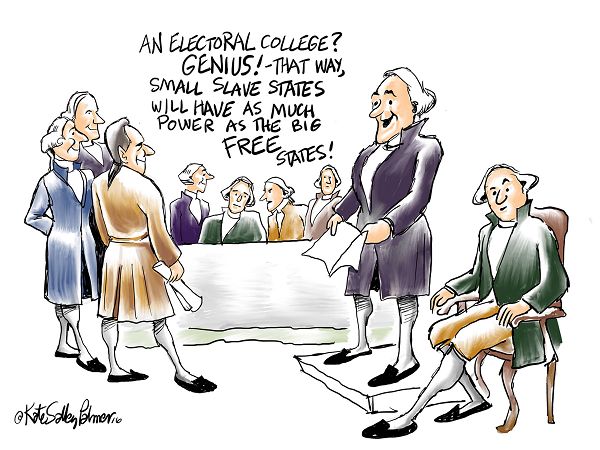
Unfortunately its true that one of the reasons the founding fathers created the Electoral College was to aid slave states, but the principle of making a state with a small population equal to a state with a large population is correct
The ignorance and gullibility concerns of Hamilton’s 18th century America have been muted by America’s 21st-century technology, a better-educated citizenry, a robust mainstream media, and the internet. Madison’s 18th century “the tyranny of the majority” concerns are not muted and are still valid in 21st century America. There are plenty of 2018 examples of the tyranny of the majority at work in States throughout the country. From partisan majority gerrymandering, partisan majority legislatures passing repressive voting laws, the majority manipulating the rules for both registering to vote and casting a vote, and the majority manipulating the rules that determine who stays on the list of registered voters and who is removed. But his “factions” concerns could become a threat to democracy in an unforeseen way if the Electoral College is removed from the election process.
The last time a presidential candidate got over 50% of the popular vote was 2008 when Barak Obama got 52.9% of the popular vote, a feat he repeated in 2012 when he was reelected with 51.1%. Before 2008 it was over 30 years ago in 1988 when George H.W. Bush (the father) got 53.4% of the popular vote. 4 years later in 1992, Bill Clinton defeated him winning only 43% of the popular vote to Bush’s 37.4% and independent candidate Ross Perot’s 18.9%. Clinton was reelected in 1996 winning 49.2%.
In 2000 George W Bush lost the popular vote but won the Electoral College vote and in 2004 was reelected winning 50.7% of the popular vote. In 2016 Hillary Clinton won the popular vote with 65 million plus votes but lost the Electoral College vote to Donald Trump. Clinton’s popular vote win was only 48% of the total of all votes cast because independent candidates Gary Johnson and Jill Stein were also in the race. In each instance where the winner of the popular vote did not win a 51% majority of all votes cast, there was a 3rd party candidate in the race.
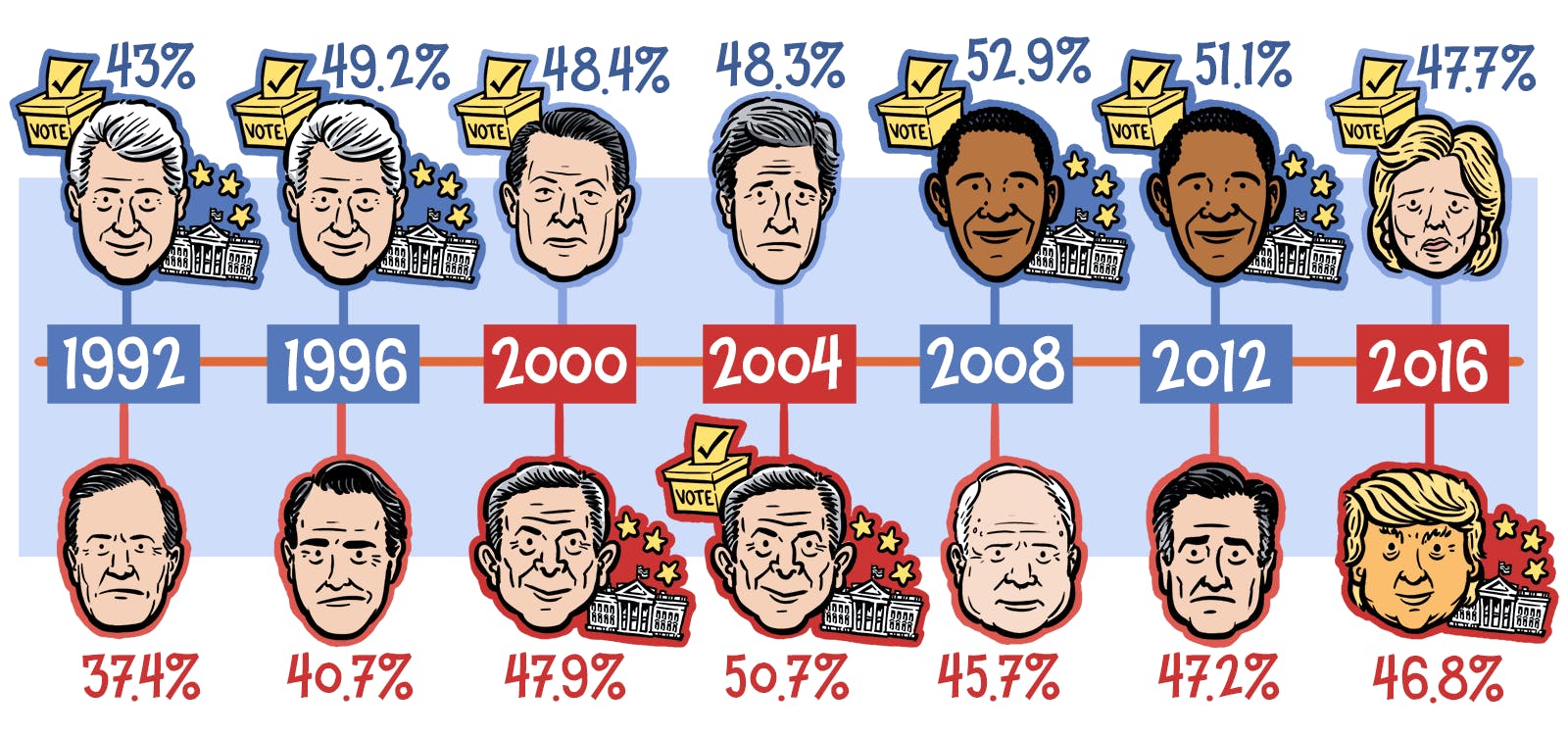
Barak Obama is the only President to win a 51% majority of the popular vote in the last 30 years, if the Electoral College is removed he might be the last
If America abandoned the Electoral College and adopted a system in which a person could win the presidency by only winning a plurality of the popular votes cast, would make the current situation worse. Because the more candidates there are in the race the fewer votes one candidate needs in order to have the most votes to win the race. In theory, a single issue candidate in a race with 10 other candidates could win the race by winning only 25% of the total votes cast. No person elected with only 25% of the votes cast could ever claim to have any mandate from the voters to truly lead and would start from day one as a very weak President.
Another problem that eliminating the Electoral College would create is the prospect of presidential campaigns ignoring states to a much greater degree than they do now. Over half (177,869,320) of America’s 329,093,110 population live in the 10 most populous states of California, Texas, Florida, New York, Pennsylvania, Illinois, Ohio, Georgia, North Carolina, and Michigan. A campaign could decide that a state like Wyoming with a population of less than a million people isn’t worth the effort. That it should focus only on the 10 most populated states and win the election without having to campaign in the other 40 states. In other words, millions of citizens would never have their votes sought after meaning their voices on the issues of the day would not be heard.
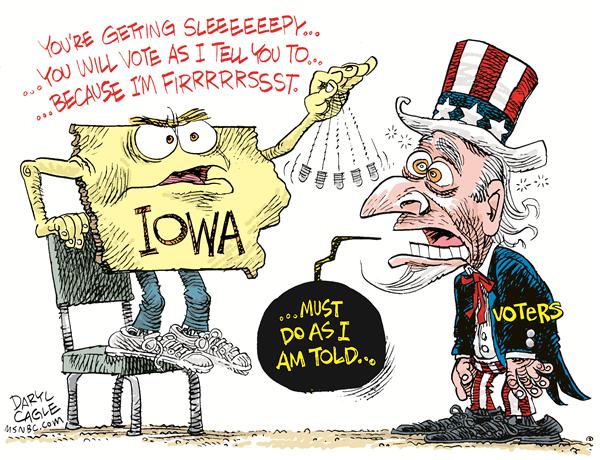
The only reason Iowa gets so much attention with such a small voting population and only 6 electoral votes is because traditionally its been the very first primary contest
The main rationale for keeping the Electoral College is that states like Iowa get the attention they would not in a true one person one vote election, but in reality, nobody goes to Iowa after the primaries for general election campaigning. The only reason people campaign in Iowa is because it’s the first primary contest and winning it can give a campaign early momentum. Once the general election campaign starts no campaign is heard saying that it needs to make stops through Iowa or Wyoming?
Because any campaign in search of votes, be they people votes or state elector votes, is going to where the greatest number of those sought after votes are gathered. Wyoming with only 3 electoral votes and Iowa with only 6 will lose out every time to the other 21 double digit electoral vote states. But one tweak of the Electoral College could change all that and make the problem of any state being ignored a true thing of the past.
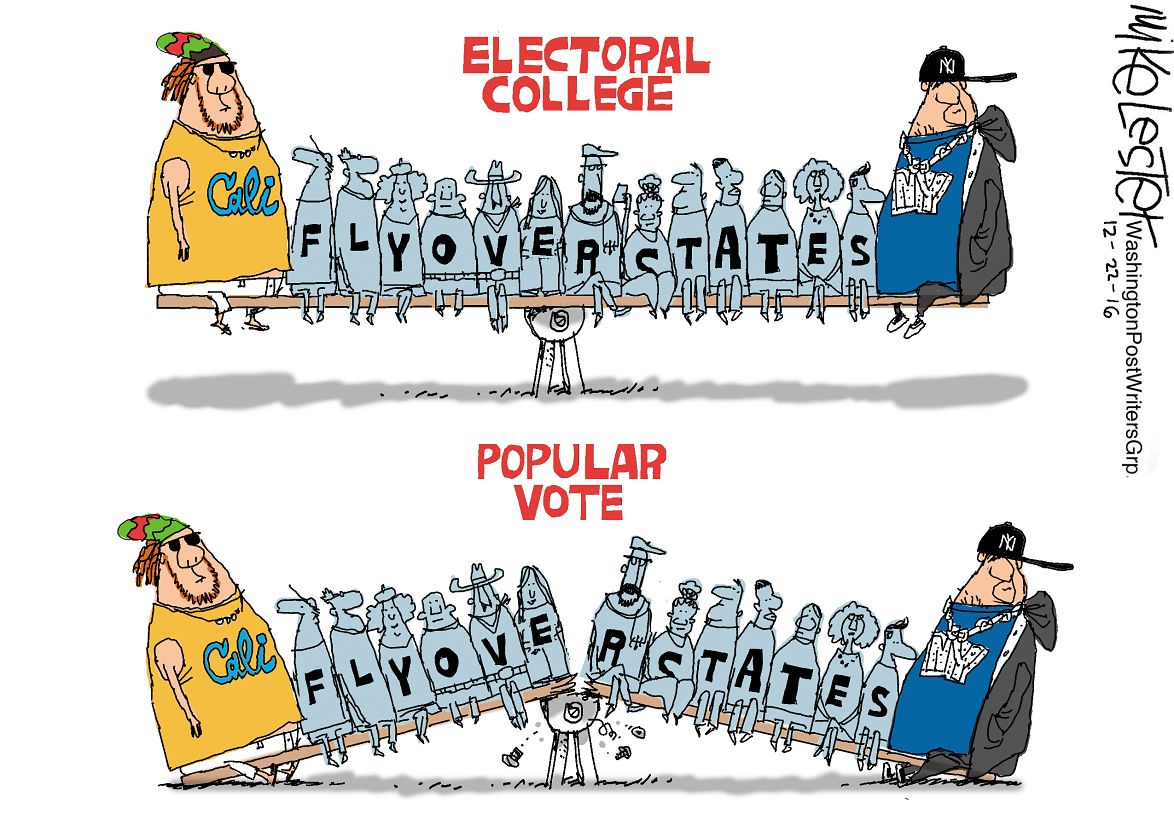
If the Electoral College was removed from the election process it would give heavy populated states like California and New York an unfair advantage under a one person one vote election process
Currently, the District of Columbia and 48 states have a winner-takes-all rule for the Electoral College. In these States, whichever candidate receives a majority of the popular vote, or a plurality of the popular vote (less than 50 percent but more than any other candidate), takes all of the state’s Electoral votes. This aspect of the Electoral College is not mandated by the Constitution and therefore it’s up to each state’s discretion which is why Nebraska and Maine, do not follow the winner-takes-all rule.
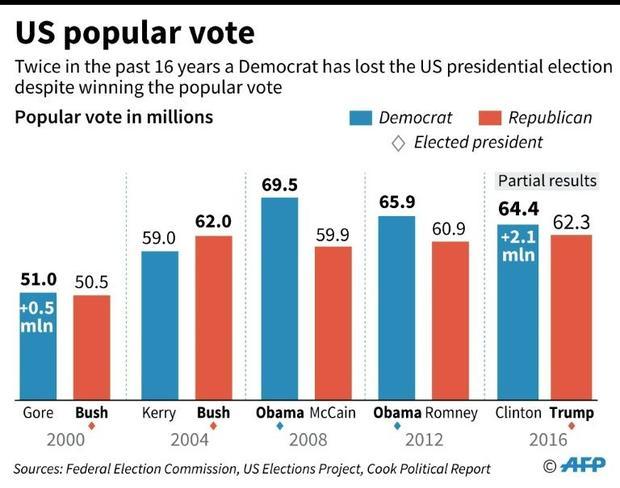
Because Democrats have won the popular vote but loss the election twice the vast majority are in favor of getting rid of the Electoral College
If each state would follow the lead of Nebraska and Maine by allocating Electoral College votes to the candidate that wins the Congressional district within the state, would make all states viable hunting grounds for all candidates looking for Electoral College votes. No longer would campaigns focus only on battleground states, a state like Wyoming or Kansas with its 6 electoral votes would no longer be overlooked, to the contrary they would be viewed as places where 1 or 2 votes could be picked off regardless of whether it’s a blue or red state.
It would make it worth it for a campaign to expend the time and resources in non-battleground states to attract the votes which could lead to 1 or 2 Electoral College votes. In both the election campaigns of Al Gore and Hillary Clinton for President, had all 50 states allocated Electoral College votes based on who won the Congressional districts within the states instead of winner take all, American history would have recorded a President Al Gore and a President Hillary Clinton.
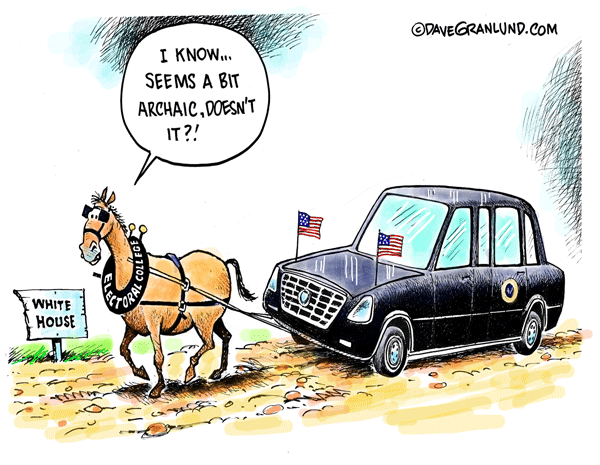
The Electoral College is currently configured for an 18th century America which can deny the will of the people’s popular vote. But a tweak in how Electoral College votes are awarded to candidates can make it a 21st century inclusive process that reflects the will of the people’s popular vote.
Like the rest of that grand document the founding fathers conceived over 200 hundred years ago, there’s logic in the concept and principle of the Electoral College that they designed. All it needs now is for 48 states to make a methodology tweak in how its Electoral College votes are awarded, which will make it as effective for electing the President in the 21st century as it was for the founding fathers when they elected the President in the 18th century.



